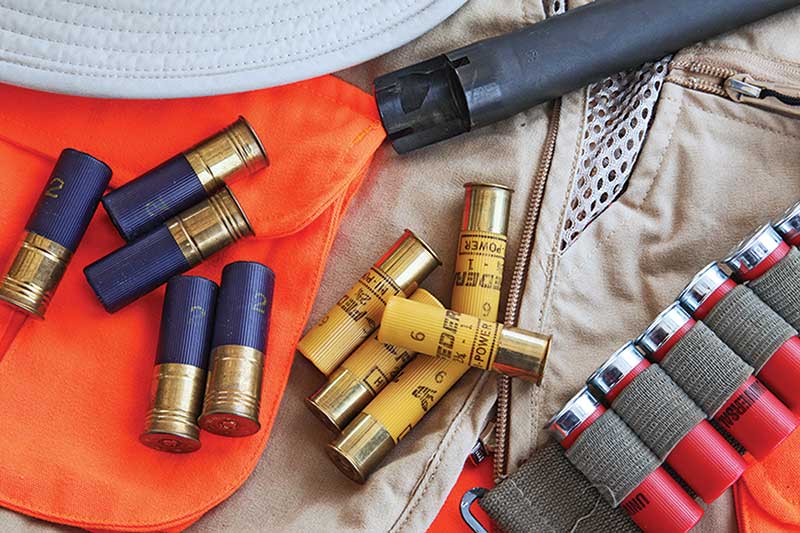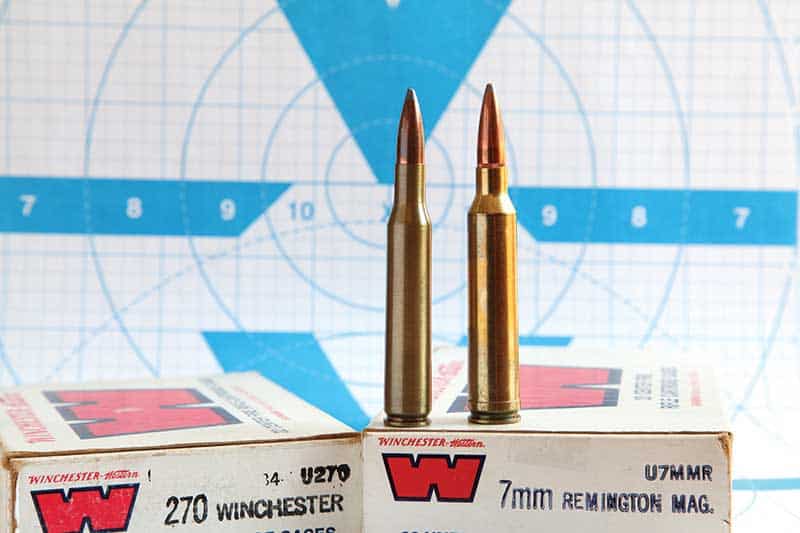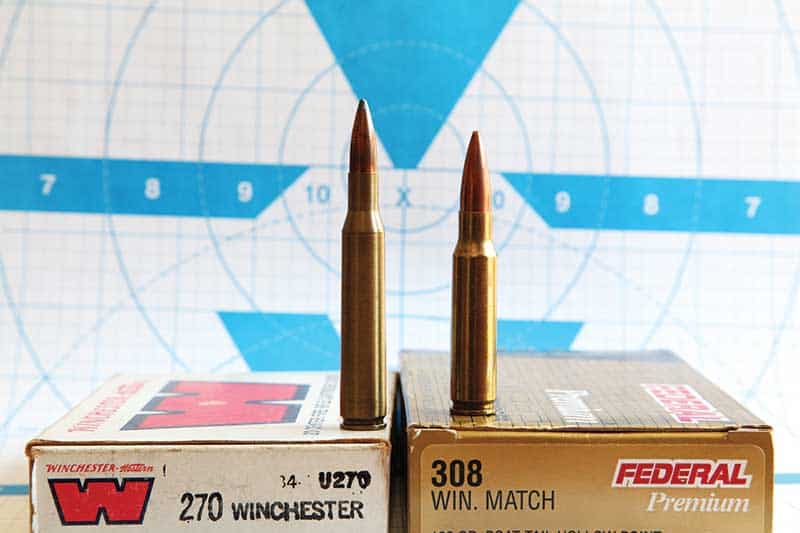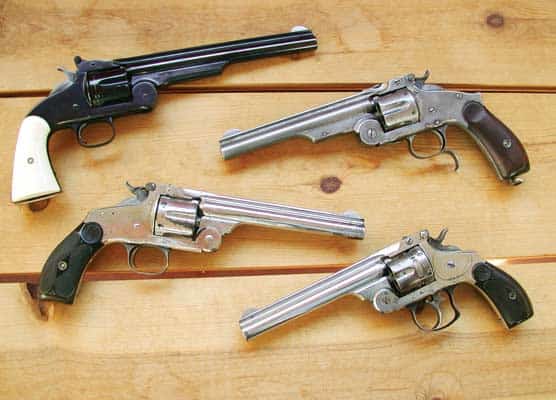Deadly Combinations
If You Have Many Different Rifles And Cartridges,
choose when you shoot which wisely

Twelve-gauge shotshells come in all sorts of colors such as the purple and red seen here.
However the color yellow has long been used only for 20-gauge shotshells, although there
are likely some very old 20-gauge shells in other colors circulating in collections. A 20-gauge
shell in a 12-gauge barrel will fall right through the chamber and be caught by the forcing cone.
A vest or coat dedicat-ed to each gauge with which you hunt is a worthwhile investment.
“I aimed carefully and squeezed the trigger. In an instant I was blinded by smoke and stunned by an explosion… I had loaded a .308 cartridge in my .270 rifle. The gun was damaged beyond repair. The stock was broken, the magazine blown out, and the barrel torn to shreds.”
I was barely into my teens when I read of this incident in the “Letters to the Editor” in the April, 1964 Outdoor Life. It must have made an impression, as I knew where to find it after over 50 years. For veteran shooters this discussion will be old news, but it may alert some of the many new shooters of potential hazards.
Why the blowup in the incident above? The .308 cartridge case didn’t seal off the chamber, and high-pressure gas got loose in the action. The same result would occur from firing a .260 Rem in a .270 or .30-06 rifle.
The .308 case simply is not long enough to seal off the longer .270 chamber. Any .308-based case (e.g. .243, .260, 7mm-08) in an ’06-based chamber (e.g. .25-06, .270, .280, .30-06) is a bad combination. The reason we hear more about .308/.270 mix-ups is because there are so many rifles made for these cartridges.
Another bad one is a .270 fired in a 7mm Rem Mag rifle. The rounds are similar in length but the .270 case is not nearly big enough in diameter to seal the larger chamber. It will certainly fail, letting high pressure gas loose.
Again, the issue would be the same with similar cartridges. We hear of .270/7mm Rem incidents more often simply because they are such popular cartridges.
Shooting 20-gauge shotshells in 12-gauge chambers have ruined many a shotgun. The 20-gauge shotshell is just big enough to drop through a 12-gauge chamber and be caught in the forcing cone. If the gunner assumes he forgot to load, and loads and fires a 12-gauge round into the obstructed bore, damage to the shotgun is a certainty.

Another bad combination is a .270 Win car-tridge fired in a 7mm Rem Mag chamber.
Here the cartridge is long enough, but far too small in diameter to seal the chamber.
When high-pressure gas gets loose the rifle will almost certainly be badly damaged,
with a very real chance of severe injury or death to the shooter or bystanders.
Shooting 20-gauge shotshells in 12-gauge chambers have ruined many a shotgun. The 20-gauge shotshell is just big enough to drop through a 12-gauge chamber and be caught in the forcing cone. If the gunner assumes he forgot to load, and loads and fires a 12-gauge round into the obstructed bore, damage to the shot-gun is a certainty.
Obviously there is great danger of severe injury or death to the shooter or to bystanders. As a visual reminder, shotshell manufacturers have an informal agreement to use the color yellow only for 20-gauge shells. At least, I’ve never seen yellow used for any other gauge than 20. On the other hand there have been and may still be 20-gauge shells in other colors.
Handloaders have dozens of powders from which to choose. There’s no system to tell by name just where a specific powder stands relative to other powders. Fortunately load-ing manuals and Internet charts are available.
I once read of a novice reloader using Hodgdon H-4831 data with IMR 3031 powder. Hey, they both have a “31,” close enough, right? His wrecked rifle said otherwise. Accurate Arms AA-7 is a considerably faster-burning powder than Alliant RL-7. Mixing these two up can lead to a wrecked gun and serious or fatal injuries.
Some shooters like to remove bolts from bolt-action rifles and store them separately as a safety precaution. Bolts are fitted individually so head-space meets industry standards and many are numbered to the receiver. If bolts get mismatched the result can be excess headspace and a blown-up rifle.

A fair question is, how can a short cartridge such as the .308 fire in a longer
(e.g. .270, .30-06) chamber? Won’t it just slide forward in the chamber, out of
reach of the firing pin? It might, with a push-feed action with recessed bolt face,
though I wouldn’t count on it. With a controlled-round-feed action the extractor
holds the case against the bolt face tightly enough the firing pin will fire the round.
How to avoid dangerous combinations? Hunter safety courses have done a wonderful job of teaching safe techniques. Experienced shooters have as well their own procedures. Here are a few I follow and recommend.
I often bring several rifles to the range, alternating them in order to let barrels cool. Having several different cartridge types on the bench is just asking for trouble. I keep cartridges in a plastic storage bin in the car or on the ground next to the bench. When setting a rifle aside to cool, the ammunition for it is put away as well. It may take a little time but the only ammunition on the bench should be for the rifle actually in use.
A basic rule of reloading safety is to have only one container of powder in use at a time. I keep powders stored in a separate location from the reloading work area. Inconvenient? A little, but some things shouldn’t be too convenient.
When a loading session is finished pour any remaining powder in measures or powder tricklers back into the original container and put it away. Is it really necessary to say don’t use unknown powders? Ninety-nine percent certain isn’t good enough. Your eyesight, your life and your fellow shooters are worth a lot more than a pound of powder.
If you use shotguns of different gauges it’s smart to have a vest or coat for each gauge. It greatly reduces the risk of a forgotten shell getting mixed up with a different gauge. Just be sure to grab the right vest!
While I applaud the safety aspect of removing a rifle bolt, I think a trigger or cable lock, or gun safe, is a better option. Separating rifle and bolt increases risk of mix-ups. It also leads to lost bolts. Every year or so I get a letter about a classic rifle, maybe a prewar Mauser or 1903 Mannlicher, with the bolt lost. Finding and having fitted a replacement is always going to be expensive and may prove impossible.






